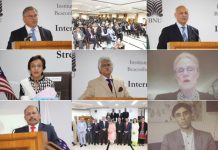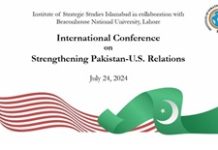Asia-Pacific Region: Future Challenges
by
Amb. Fauzia Nasreen
Head, Centre for Policy Studies, COMSATS
Introduction
The Asia-Pacific region has been characterized as a melting pot or a “cauldron” by Robert Kaplan. The region faces several challenges related to geo-strategic compulsions based on the historical experiences of countries located especially in the South China Sea. The US has emerged as a crucial player even though an outside power with historical presence. US policy statements categorically state that the US has always been a Pacific power and has an abiding interest in the area. Given the globalized nature of the US diplomatic, political, economic and geo-political interests and priority accorded to maintaining its status as the leading world power, US desire is to shape the international order and norms in accordance with US values and interests. In addition to economic and strategic goals, the US has indicated its commitment to this objective in the context of deterring and dissuading as well as countering what it describes as anti-access and area denial threats. However, this status of the US is challenged by the other powers who are striving for a multipolar system. China’s emergence as one of the leading economies of the world and its vital interests in the South China Sea are seen as challenging by the US and its allies in the region. The US “Pivot to Asia” and the Chinese “One Belt, One Road” and high stress on infrastructure development across Asia indicate opposing concepts of the two major powers. China is Pakistan’s strategic and “all weather” friend and partner. The expanding role of China in the development of Asian regions and maritime route encompasses the Indian Ocean and Western Pacific which enhances relevance of Pakistan-China ties. Notwithstanding the ups and downs in Pakistan-US relations, the partnership is of an indispensible nature with both Pakistan and the US maintaining immediate concerns about peace and stability in West Asia and Afghanistan. The US rebalancing strategy towards Asia-Pacific has evoked mixed sentiments among the major actors in the region of South China Sea and beyond and has created certain strains in China-US relations.
US Rebalancing Strategy: The review of the US global strategy was conducted after 2009 when the Obama administration took over. This was preceded by an era where Bush administration remained preoccupied with War on Terror. The review had concluded that the US troop deployment and focus was heavily tilted towards Europe, the Middle East (Iraq) and Afghanistan. In the backdrop of heavy economic cost and general fatigue, the Obama administration decided to move out of Iraq and announced draw down of its troops in Afghanistan by December 2014. This was also partly necessitated by the financial crisis of 2008 and recession in the US economy.
Rethink of Global Strategy: The rethinking of Global Strategy was first reflected in the statements and overtures of US officials. The then Secretary of State Hilary Clinton clearly demonstrated orientation towards East Asia during her visits to the region in 2009. The aim was to intensify engagements both at bilateral and multilateral levels. These engagements included China as well that had already consolidated its economic and diplomatic ties with the Asia-Pacific countries.
The pronouncement of the Rebalancing was first made in June 2011 by US Secretary of Defense in Singapore. He mentioned the US desire to seek a “geographically distributed, operationally resilient and politically sustainable” US force posture. The focus of the approach, he said, would be on air superiority and mobility, long range strikes, nuclear deterrence, maritime access, space and cyberspace, intelligence, surveillance and reconnaissance capabilities in the context of the Asia-Pacific region.
The detailed explanation of the Rebalancing strategy was then outlined in Secretary Clinton’s article entitled “America’s Pacific Century” which appeared in Foreign Policy in October 2011. She mentioned the rising threats to America in the region and implicitly alluded to China that had emerged as the biggest trading partner of the ASEAN countries. Six features of this new shift included: consolidation of bilateral security alliances; strengthening of relationship with China as an emerging power; enhanced interaction with regional multilateral institutions; tightening of trade and investment links; ensuring a broad-based military presence; and engaging with countries of the Pacific to further democracy and human rights.
US Strategic Guidance of 2012: The review of US global strategy was revealed in the US Strategic Guidance document of January 2012 entitled “Sustaining US Global Leadership: Priorities for a 21st Century Defense”. This document provided insights into the strategy that would comprehensively deal with the challenges and threats from multiple sources. The core of this strategy was developing US military forces for the future (up to 2020). President Obama underscored that “as the (US) end today’s wars, (the US) will focus on broader range of challenges and opportunities, including the security and prosperity of the Asia-Pacific.”
In line with this objective, US Secretary of Defense stated that this renewed focus on the Asia-Pacific would require “shaping a joint force for the future that will be agile, flexible, ready and technologically advanced.” This force was to have global presence with an added emphasis on the Asia-Pacific. The rationale for the Rebalancing Strategy mentioned the US economic and security interests which were “inextricably linked to developments in the arc extending from the Western Pacific and East Asia into the Indian Ocean region and South Asia, creating a mix of evolving challenges and opportunities.”
The Strategic Guidance also stressed that consequently the US military “will of necessity rebalance toward the Asia Pacific region.” Since relationships with its allies and key partners in the region were critical to the economic growth and stability of the region, the US would aim at increased emphasis on alliances and expanding networks of cooperation. In this context India was mentioned for long-term strategic partnership as a “regional economic anchor” that would “provide security in the Indian Ocean.” The document identified China, the emerging regional power, as affecting the US economy and security in multiple ways.
The geographical and strategic shift in priorities towards the Asia Pacific, showed US determination to project power and effectively deal with what it saw as anti-access and anti-denial challenges in the region. As a deterrence strategy, the US reaffirmed that it will project its power in areas where it has access and operates freely. The US would also defy such limits as Air Defense Identification Zone and other restrictive measures. This has posed a challenge for China, which has repeatedly stated that because of geographical reasons it had interests all over the South China Sea.
Chinese perceptions: References in the US strategic re-posturing have been made to China both in terms of constructive cooperation and containment. The Chinese perspectives on the Rebalancing Strategy reflect deep mistrust of the US intentions towards China’s overall growth and development as well as its position in the Asia-Pacific region. As explained by the former Australian Prime Minister Kevin Rudd in his April 2015 paper “The Future of US-China Relations under Xi Jinping”, China sees “America as deeply opposed to China’s rise, driven to do whatever it takes to prevent” its rise as a regional and global power. In this connection, the Chinese point to US rebalancing towards Asia-Pacific as an unequivocal evidence of this strategy. On his part, Xi Jinping has propounded the concept of “new type of great power relationship” between the US and China eschewing the politics of “zero-sum game.” On its part, the US has also talked about instituting a “new model of relations” with China.
Kevin Rudd and other scholars like Robert Kaplan rule out the possibility of armed conflict between China and the US as it would be disastrous for both. However, an era of stable Pacific is bound to end given the “strategic chill” between the two major powers. Rudd also says that the Chinese military modernization and expansion may not be aimed at inflicting a defeat on the US, but to deter its navy from intervening in China’s immediate periphery. However, vulnerability remains particularly in view of the US resolve to challenge China’s attempts to limit US activities and the US President making categorical remarks that the US “will fly, sail, and operate wherever international law permits.” The US’ continued incursions into the zone limits set by China could be potentially dangerous.
So far both the US and China have refrained from an outright military clash, but both have tried to demonstrate their resolve to contest any transgression by the other side. The Chinese are trying to allay apprehensions that Beijing is militarizing the islands in the South China Sea, but at the same time, as stated by the Chinese Foreign Ministry, “there is no way for (China) to condone infringement of China’s territorial sea and air space under the pretext of maintaining freedom of navigation and over flight.” On the other, hand President Obama has reiterated the US objective of opposing Chinese goals.
The escalating tension does not bode well for the region where rapid economic growth is seen as healthy for the global economy. Securitization of the region will certainly affect the growth rate of ASEAN and other countries as resources will be diverted to military purchases and cordiality in the region will be marred. It would also disrupt the free trade arrangements and adversely affect the implementation of the Trans-Pacific Partnership agreement as countries will be expected to take sides in the vortex of “balance of power.” “The end of a stable Pacific” will have ramifications for all the Asian regions as conflicts are rife in most parts of Asia. With the intensifying hostilities in the Middle East and dynamics of South Asia (fragility of Afghanistan and renewed thrust of the Taliban), Rebalancing, if not managed constructively, will be counter-productive even for the freedom of navigation.
Conclusion: While both China and the US are vying for influence and status in the Asia-Pacific region, they are cognizant of the adverse consequences of taking competition too far. As rational actors, the two would give preference to their economic stakes which are dependent on freedom of navigation and the ability of the two countries to preserve unhindered trade through the strategic water ways and straits in the Indian Ocean and the Pacific Ocean. South Asia’s location becomes even more important in terms of Sea Lines of Communication (SLOCs).
While Pakistan-China strategic relations will further China’s policy of “string of pearls”, India has been considered as a “swing state” by the US strategists. Indian response to the rebalancing is characterized by ambivalence. China-India economic relations have expanded at a fast pace in recent years. Bilateral trade is over US$80 billion and China has taken India into confidence about its One Belt, One Road (OBOR) project. Beijing has offered substantial assistance to New Delhi for infrastructure development projects including those related to the 21st Century Maritime Silk Road. The two are in BRICS and G-20. India has contributed to the Asian Infrastructure Investment Bank (AIIB). Yet, India has strategic partnership with the US and regularly participates in naval exercises in the Indo-Pacific region. The territorial disputes between China and India have occasionally caused rhetorical exchange of threatening words between the two sides.
Pakistan’s strategic relations with China and the unfolding of China-Pakistan Economic Corridor (CPEC), connecting China (Kashgar) to Gwadar, might have raised concerns among other powers active in the Indian Ocean and Western Pacific. However, the common challenge and goals of all the powers should focus on freedom of navigation and unhindered trade and commerce. With cooperative engagement battle for markets and access to various regions in Asia and Africa must be a win-win for all. If the world economy is to bounce back and interests of various world regions are to be ensured, all countries must be provided space to develop their potentials for the benefit of their people. This is the best way of ensuring human security and combating destructive forces.
References
- The National Security Strategy, February 2015 issued by the White House, www.whitehouse.gov
- Emmers, Ralf, The US Rebalancing Strategy: Impact on South China Sea, 2013, www.nsc.anu.edu.au
- Davis, Malcolm R., Arms Race, Security Dilemma and Territorial Disputes, 2013, www.epublications.bond.edu.au
- Mills, C.C., The United States’ Asia-Pacific Policy and the Rise of the Dragon, Indo-Pacific Papers, 2015, www.defence.gov.au/ADC
- Berten David J., Green Michael J., Cooper Zack, Assessing the Asia-Pacific Rebalance, Centre for Strategic and International Studies, 2014 www.CSIS.org/files
- Pivot to the Pacific? The Obama Administration’s “Balancing” Toward Asia, CRS Report to Congress, Congressional Research Service R2448, 2012, www.fas.org/sgp/crs
- Berten David J., Green Michael J., Cooper Zack, Assessing the Asia-Pacific Rebalance, Centre for Strategic and International Studies, 2014 www.CSIS.org/files
- Kaplan, Robert D. Asia’s Cauldron: The South China Sea and the End of a Stable Pacific, Random House, 2014.
- Kaplan, Robert D., Monsoon: The Indian Ocean and the Future of American Power, Random House, 2010.
- Ratner. E, Rebalancing to Asia with and Insecure China, 2013, www.csis.org.files/publications
- Roberts, Tom and Phillips, Tom, US threatens naval incursions despite furious reaction from China, the Guardian, 27 October 2015, www.theguardian.com













